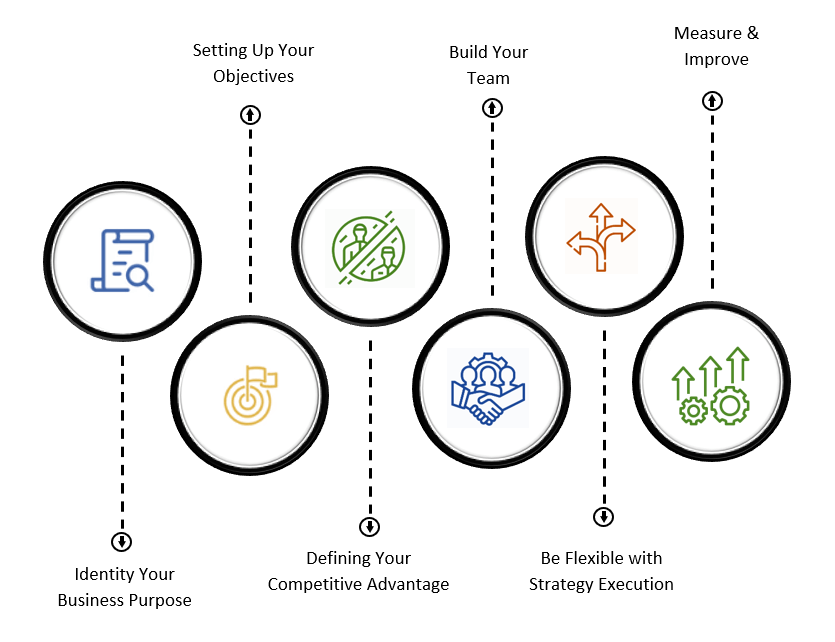The Importance of Business Strategy
What is a Business Strategy?
Every business has natural weaknesses within all organizations for various reasons. What a business strategy does is try to remedy these weaknesses so that companies don’t trip up and suffer their impact too greatly. The strategy helps us define our business, gives it a set of values, and gives it purpose and provides a roadmap for our business, shows us our destination, and identifies useful stopping points along the way.
A business strategy refers to all the decisions taken, and actions undertaken by a business for achieving the larger vision. Precisely, it is the backbone of every business, and any shortcomings could mean that the business goals get lost midway.
Why Business Strategy is Important?
A business objective without a strategy is just a dream. It is no less than a gamble if you enter into the market without a well-planned strategy. With the increase in competition, the importance of business strategy is becoming apparent and there’s a huge increase in the types of business strategies used by businesses.
Here are five reasons why a strategy is important for your business:
1. Plan
A business strategy will first and foremost set the direction for your company. With a clear direction, your business will have something clear to work towards. While it might be your dream to be the biggest supplier of a certain product, a business strategy will set this as a clear target to aim towards.
2. Decision
Without direction and sense of purpose, it is difficult to assess the merit of certain decisions. Investing in a new asset may make clear sense with a goal to expand distribution, but may not seem like a wise choice otherwise. A business strategy will give you a clear vision that will help you to determine between good and bad decisions.
3. Competition
Companies without a business strategy will often look at their competitors for ‘best practice’ and this can lead to competitive convergence. With competitive convergence it can become impossible to determine between the companies and the market can become diluted. With a business strategy, however, you can implement a unique plan that will make you stand out from the crowd instead of just following trends.
4. Trends
A strategy can identify trends and opportunities in the future. It can examine the broader changes in the market such as political, social or technological changes, as well as consumer changes, and can develop tactics so your business can modify and develop to suit these future changes.
Developing a Strong Business Strategy

Step 1: Identify Your Business Purpose
The key to an exciting, successful business is to identify a Massively Transformational Purpose that you can build your enterprise around. This way, you’re building success through revolutionary ideas and development that serves to make life easier for your customers.
Step 2: Setting Up Business Goals
One important step in developing a successful business strategy is establishing clear and measurable business goals. The more specific and measurable these goals are, the better they can guide your overall business strategy.
Step 3: Defining Your Competitive Advantage
One of the key steps in developing a successful business strategy is identifying your competitive advantage. This involves pinpointing what sets your business apart from the competition, including your unique knowledge and capabilities.
Step 4: Build Your Team
Team building strategies are practices that organizations use to get their teams working well together. For example, defining team roles and rewarding excellence. These methods contribute to creating an environment where employees feel empowered to do their best. As you articulate your Business Strategy, you’ll need to assemble a team that combines practical experience and skills with innovative thinking. Below are the lists of team building strategies:
- Promote a respectful environment
- Open the lines of communication
- Define team roles
- Trust in your team’s efficacy and lean on their strengths
- Reward, appreciate and acknowledge excellence
Step 5: Flexibility in Executing Business Strategies
Make active progress in measuring the impact of your strategy. Many businesses lean on AAARRR metrics, also called Pirate Metrics, to understand and track their transformation’s effectiveness. Using the Pirate Metrics framework, you can follow how a prospective customer becomes a repeating customer through the funnel of Acquisition, Activation, Retention, Revenue, and Referral.
Step 6: Measure and Improve
In order to achieve your business goals and maintain a competitive advantage, it is crucial to be flexible in executing your business strategies. If something isn’t working or if market conditions shift, it is important to pivot your business strategies accordingly. Don’t be afraid to allocate more resources towards a particular goal or objective if needed. Remember, being flexible and adaptable is key to long-term success in the business world.
The Unite Pirate Metrics Funnel (AAARRR)
A - Awareness
How many people do we reach with our marketing? How do we get people to visit us? Which channels are they using?
R - Revenue
How many people actually become customers and how much do they spend? What are we doing to sell, up sell and cross-sell?
A - Acquisition
How many people do we reach with our marketing? How do we get people to visit us? Which channels are they using?
R - Retention
How many customers are sticking with us? What are we doing to ensure that users come back?
A - Activation
What is our WOW moment (the moment where you achieve to go beyond customer expectations and requirements)?What do we consider an active user?
R - Referral
How many customers promote us? What are we doing to encourage virality?
Key Components of a Strong Business Strategy
Business strategies come in all shapes and sizes and can vary significantly in their depth. Most business strategy documents will however contain the following:
1. Vision and Objectives
A business strategy is intended to help you reach your business objectives. The vision element of this provides a clear direction for the business. This enables you to develop tactical instructions within the business strategy for what tasks need to be completed, and which of your resources are responsible for completing them.
2. Core Values
A business strategy guides leaders, as well as departments, about what should and should not be done, according to the organization’s core values. Defining the organizations core values helps to ensure that employees are on same page, and with the same goals.
3. SWOT (Strengths, Weakness, Opportunities and Threats)
For any business, understanding its strengths, weaknesses, opportunities and threats is critical. This is a core part of any business strategy, and ensures that humility, and self-awareness are present. Understanding this helps to define where the organization can win, and areas that must be addressed in the future.
4. Tactics and Operational delivery
The tactical element of a business strategy will set out the operational details that define how the work should be delivered. Tactical delivery is critical for the success of any business strategy, and managers who have responsibility for tactics understand what needs to be done. This ensures that time, and effort is not wasted.
5. Resources and Allocation
Generally, the resource element of a business plan will cover the allocation of existing resources, as well as where additional resources will be found. Most businesses rely on many different resources, people, technology, financial, and physical resources. Having a clear picture of these, and future requirements enables leaders to see where to add more resources in order to achieve their goals.
6. Measurement and Analysis
The evaluation phase places emphasis on how a business is performing in relation to the business strategy. Measurement, helps you to stay closely aligned to the strategy, define deadlines and goals and address things such as budget concerns. Nowadays, data and business intelligence platforms play a crucial role in this phase.
Implementing Your Strategy: Tips for Success
Implementing a successful business strategy requires more than just developing a plan. Here are some tips for effectively implementing your strategy:
Communicate Clearly
Ensure that all employees understand the company’s strategy and their role in achieving it. This may involve regular meetings or training sessions.
Monitor Progress
Regularly evaluate progress toward your goals and adjust your tactics as needed. This will help ensure that your strategy remains relevant and effective.
Foster Collaboration
Foster Collaboration: Encourage collaboration between departments and employees to ensure that everyone is working together toward the same goals.
In conclusion, developing a strong business strategy is essential for the success of any organization. It provides clarity and focus, enables informed decision making, enhances competitive advantage
FAQ :
Your business strategy should be reviewed on a regular basis, ideally once a year or whenever there are significant changes in your business environment.
Yes, a strong business strategy is essential for the success of any organization, regardless of its size.
The risks of not having a strong business strategy include losing market share to competitors, making poor decisions, and missing out on opportunities for growth and profitability.
Blogs you might find useful :

We're here to help you! Reach out for solutions.
We're here to help you! Reach out for solutions.
Don't let doubts hold your business back.

Have any questions? Reach us by phone.

We're here for you! Reach us by mail.
Contact Us
We Always here to help you!
Business Setup
Tax Services
Consulting Services
Accounting Services
Compliance
Audit & Assurance
Quick Links

MARKEF is a leading Accounting Firm offering wide range of services including Accounting and Bookkeeping, Audit and Assurance, VAT and Corporate Tax, Business Consulting, Management Consulting, and Business Setup Services in Dubai and across United Arab Emirates.
- Office No.1929, Tamani Art's Offices Tower, Business Bay, Dubai, United Arab Emirates
- +971 4 589 2828
- +971 50 105 4241
- E-mail : info@markef.com
-
Mon - Sat : 8:00 - 18:00
Sunday Closed


